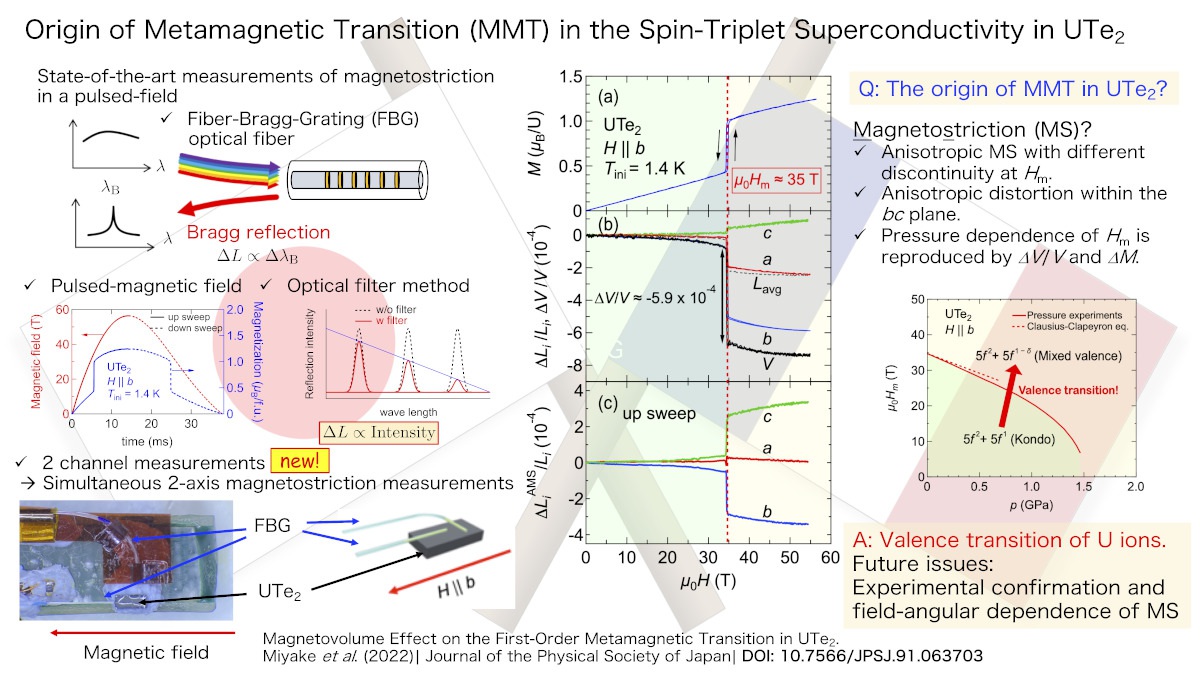Origin of Metamagnetic Transition (MMT) in the Spin-Triplet Superconductivity in UTe2
© The Physical Society of Japan
This article is on
Magnetovolume Effect on the First-Order Metamagnetic Transition in UTe2
(JPSJ Editors' Choice)
J. Phys. Soc. Jpn.
91,
063703
(2022)
.
State-of-the-art magnetostriction measurements in a pulsed-magnetic field reveal the origin of a metamagnetic transition of spin-triplet superconductor UTe2. We propose that the uranium valence fluctuation plays a crucial role in its metamagnetic and superconducting transitions.

The metamagnetism realized in heavy fermion systems has been well studied to date. At the metamagnetic transition/crossover fields, magnetization increases discontinuously/non-lineally, and fluctuations develop. Consequently, the effective mass increases. Thus, the metamagnetism may induce a new quantum state, such as a superconducting transition. The uranium-based ferromagnetic superconductors have been good playgrounds to study the relationship between metamagnetism and superconductivity. Quite recently, another related system, UTe2, was discovered.
The superconductivity in a paramagnetic heavy fermion system, UTe2, became a hot topic in condensed matter physics community since the realization of the spin-triplet state, which is expected for use in quantum computing. The external stimuli, such as pressure, magnetic field, and its applied direction, make UTe2 more attractive. The most remarkable feature is the magnetic-field-direction controlled superconductivity. For H || baxis, superconductivity is reinforced by increasing the fields but is killed at the metamagnetic field Hm~ 35 T, where a first-order metamagnetic transition takes place. However, the field applied near the orthorhombic [011] direction induces another superconducting phase above Hm. Because experimental probes usable under such extreme conditions were limited, the role of metamagnetic transition in the appearance/disappearance of superconductivity is far from complete understanding. Moreover, the metamagnetism in UTe2must be more clarified. These still remain a big challenge for experimentalists.
Magnetostriction, that is, the length/volume change with magnetic field, should offer hints at the aforementioned issues. The authors have developed magnetostriction measurements combining the fiber Bragg grating fiber optics and optical filter method that cover a wide range of ultra-high-magnetic fields beyond 100 T. A new attempt demonstrated in this article is simultaneous magnetostriction measurements up to 55 T. We obtained the linear magnetostriction along the two principal axes within a one-field scan; thus, we could perform measurements efficiently. This improvement also enables us to confirm the reliability and reproducibility of the magnetostriction measurements. Using a single crystal of UTe2, we revealed the magnetostrictions along all principal axes and the volume change at Hm.
Across Hm approaching from the lower fields, the volume shrinks discontinuously. This volume discontinuity well explains the pressure dependence of Hm and magnetic susceptibility reported earlier. Furthermore, we revealed that the metamagnetic transition in UTe2 involves anisotropic lattice deformation. Considering the localized and itinerant duality nature of uranium ions, we proposed that the uranium valence transition is the origin of metamagnetism. We also discussed the singular behavior in UTe2by comparing it with the other heavy fermion systems. Our findings deepen the understanding of the fascinated physics realized in UTe2.
(The figure has been replaced as of July 19, 2022)
(Written by A. Miyake on behalf of all authors)
Magnetovolume Effect on the First-Order Metamagnetic Transition in UTe2
(JPSJ Editors' Choice)
J. Phys. Soc. Jpn.
91,
063703
(2022)
.
Share this topic
Fields
Related Articles
-
Higher-Order Topological Phases in Magnetic Materials with Breathing Pyrochlore Structures
Electronic structure and electrical properties of surfaces and nanostructures
Magnetic properties in condensed matter
Mathematical methods, classical and quantum physics, relativity, gravitation, numerical simulation, computational modeling
2025-4-7
A simple example of a higher-order topological phase, in which the symmetry decreases step-by-step from the bulk to the corner, is realized in a magnetic system with a pyrochlore structure and is characterized by a series of quantized Berry phases defined for the bulk, surface, and edge.
-
Existence of Chiral Soliton Lattices (CSLs) in Chiral Helimagnet Yb(Ni1-xCux)3Al9
Magnetic properties in condensed matter
2025-4-1
Our study examines the magnetic structure of the monoaxial chiral helimagnet Yb(Ni1-xCux)3Al9, providing first direct evidence of the formation of chiral soliton lattice state.
-
Fractional Vortex Array with Nontrivial Topological Structure Realized at Twin Boundary of Nematic Superconductor
Superconductivity
2025-3-24
Analysis of the two-component Ginzburg-Landau theory suggests that a conventional vortex is transformed into two fractional vortices with the topological nature of core-down and core-up merons at the twin boundary of a nematic superconductor.
-
Exploring the Vibrant Interplay of Machine Learning and Physics
Cross-disciplinary physics and related areas of science and technology
Electron states in condensed matter
Elementary particles, fields, and strings
Mathematical methods, classical and quantum physics, relativity, gravitation, numerical simulation, computational modeling
Statistical physics and thermodynamics
Superconductivity
2025-3-13
This Journal of the Physical Society of Japan Special Topics edition explores how physics and machine learning complement each other and can solve unresolved problems in physics.
-
Understanding Pressure-Induced Superconductivity in CrAs and MnP
Magnetic properties in condensed matter
2025-3-10
This study reviews existing research on the pressure-induced variation of magnetic properties of transition metal mono-pnictides like CrAS, MnP, and others, aiming to understand the unconventional superconductivity observed in CrAs and MnP.




